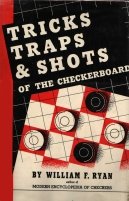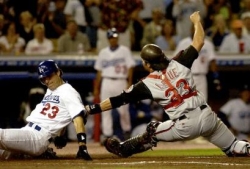The Checker Maven
The World's Most Widely Read Checkers and Draughts Publication
Bob Newell, Editor-in-Chief
Published each Saturday morning in Honolulu, Hawai`i
Contests in Progress:
Pages: «Prev
|
1 |
2 |
3 |
...|
60 |
61 |
62 |
63 |
Next»
Masterpiece
Here is an elegant problem by an unknown author, as originally published by Tom Wiswell. It is not easy but is worth the effort.
BLACK
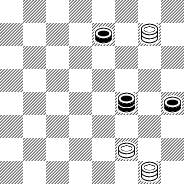 WHITE
White to Play and Win
WHITE
White to Play and Win
Mr. Wiswell called it
Masterpiece and we're sure you'll agree when you have it figured out. His solution can be seen by clicking on
Read More.
What, indeed, makes a problem a true masterpiece? Is it an elegant solution, a deep or hidden theme, a surprise ending, or other factors? We'll combine today's problem with this short survey asking what you like most in a checker problem.
[Read More]
Yet Two More Easy Pieces
We continue our electronic republication of Willie Ryan's classic
Tricks Traps & Shots of the Checkerboard with this, our third installment. But let's let Willie speak for himself.
EXAMPLE 5
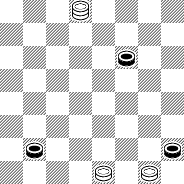 White to Play and Win
White to Play and Win
'Like all other tactical schemes, the delayed smother play can occur on other parts of the board with varying arrangements of the pieces. Example 5 shows a natural-looking ending in which white can neatly bottle up black's pieces in just five moves, by a delayed double corner "jam." Examples 4 (
published in a previous article --Ed.) and 5 illustrate but two types of the smother play; there are several other varieties including blocks, freezes, lock-ups, and the smother pinch. Indeed, checker ideas are as numerous as words, and each one has a meaning of its own, and a special adaptability in the course of scientific play.
EXAMPLE 6
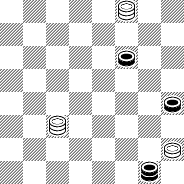 White to Play and Win
White to Play and Win
The situation on the right (
actually above --Ed.) is still another member of the smother family. To press home the win in Example 6, white must actually coordinate the germs of two different tactical ideas, employing the smother as the winning device and using the seesaw shift (as in Example 11) (
to be published by July 2005 --Ed.) as the timing element by which the smother is executed. When two or more tactical ideas are woven into a procedure of force, we call it a "combination." positions are always popping up in play where it is necessary to grapple with a dozen or more ideas in order to force a scientific win, or obtain a delicate draw!'
Solve the problems and check your solutions by clicking on Read More.
[Read More]
Speeding Into Spring
Spring is here, it's April, and time for our more-or-less monthly selection of speed problems. Remember, the clock is running. How fast are you?
No. 1 (two ways to solve, easy and very easy)
No. 2 (easy to medium)
Click on Read More for the solutions.
[Read More]
Wednesday is 'Anything Can Happen Day'
At the suggestion of our readers, instead of publishing everything on the weekend, we'll be trying out the idea of dividing up our new articles between Wednesday and Saturday. Although we'll
likely feature a problem on most Wednesdays, "anything can happen" so stay tuned, and be sure to let us know what you think of our revised publication schedule.
Now, on to this week's Wednesday problem. Originally published over 80 years ago, it was billed as a beginner's problem. And it's surely a case of "anything can happen" in that there were flaws in the original setting, clever though it was, and so we've made a few changes.
We start with this position, as originally published:
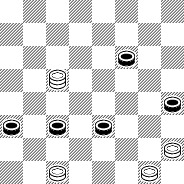 White to Play and Draw
White to Play and Draw
The published solution gave 14-17 to a draw, and that is correct; however, computer analysis shows that both 14-10 and 14-9 will also draw. Too many solutions spoil the problem.
But in the diagram above, what is the move that comes to mind at once, and that a beginner in particular would likely choose? It's 14-18, attacking two Black men at once. Yet this move loses! Here's the position, and the challenge for you:
WHITE
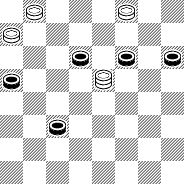 BLACK
Black to Play and Win
BLACK
Black to Play and Win
Did you get it? Click on Read More for the solution, and decide for yourself, though this is a situation a beginner might encounter, if this is truly a beginner's problem.
By the way, you get bonus points if you can recall where the idea of Wednesday being "Anything Can Happen Day" originally came from.
[Read More]
The 'Masked Man' Returns for March
We're pleased to present our
Masked Man problem for March. The challenge is twofold; solve the problem, and identify the composer, who is pictured in the photograph above.
Here's the problem:
WHITE
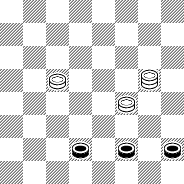 BLACK
Black to Play and Win
BLACK
Black to Play and Win
We won't keep you waiting this time, so click on
Read More to check your answers... but please do try the problem first, as it's a nice one.
[Read More]
No Work Today: A Midweek Bonus Problem
It's stormy today (March 15, 2005) in the mountains of New Mexico and our office has been closed for two days straight. Although The Checker Maven usually publishes on weekends, today is special, and we invite you to warm by the fire with this midweek bonus problem.
BLACK
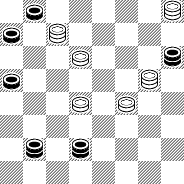 WHITE
White to Play and Win
WHITE
White to Play and Win
Can you see your way through this one? Stroke problems, artificial as the settings often are, make for great visualization practice. So, when you're ready, click on
Read More to check your solution.
[Read More]
Avoidance Maneuver
Sometimes in a checker game you try to achieve a certain position, formation, or situation; and at times it's just the opposite. That principle leads us to this month's first teaser.
Here's the layout:
BLACK
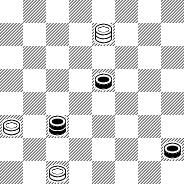 WHITE
White to Play and Draw
WHITE
White to Play and Draw
Look easy enough? It's a bit easier than some others we've featured, but this one has been known to frustrate experienced players. Give a whirl, keeping the title in mind, and then click on
Read More to check your solution. Were you able to ..... oops, we'd better not give it away!
[Read More]
Two More Easy Pieces
We're continuing our long-term project of electronic republication of Willie Ryan's
Tricks Traps & Shots of the Checkerboard with another pair of introductory problems. As usual, Willie's own inimitable commentary accompanies each. When you've worked out your solution, click on
Read More to check your answers.
EXAMPLE 3
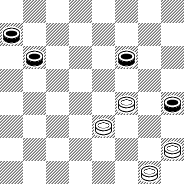 White to Play and Win
White to Play and Win
'Basic ideas never change, but they may occur on different areas of the board with more or fewer pieces involved. In Example 3, we have a snap layout of a double corner compound in which the winning plan is precisely the same as the one used in Example 2, but the arrangement of the pieces is different. A common fault of the beginner is his tendency to associate a particular tactical idea with only one position. This is undoubtedly an obstruction to progress. The main purpose of studying a problem position is to master the idea (or ideas) it illustrates so that the student may use it in
any other situation where the same idea can be successfully applied.'
EXAMPLE 4
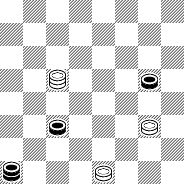 White to Play and Win
White to Play and Win
'One of the more spectacular fundamental principles is the "smother" idea. Example 4 frames an easy setting of a delayed smother coup in which first black's piece on square 22 is driven to a fatal spot (square 25), and then white makes two sacrifices in succession, winning by a weird tie-up. The description given to each example in this review of basic ideas is intended to help the reader to develop concepts of logical procedure. If we say "delayed smother" we mean the smother is not immediate, but that white can force black to make a certain move (or moves) that enables white to drive black into the coup position.'
[Read More]
March Speedsters
To start the month, here are two more speed problems, with the timer running to see how fast you can find the solutions:
No. 1. Very easy.
No. 2. Easy.
After you've solved them, click on Read More to check your answers.
There's the green flag ..... go!
[Read More]
Life Is Full of Tough Choices
The last offering for February is two problems in one. It's based on something published by Willie Ryan many years ago. The adaptation of the setting is rather liberal.
Here's the situation. You're in the final round of the Mega-Bowl of Checkers. The coveted title of Supreme Exalted Checker Champion hangs in the balance. Thousands of avid fans are watching from their $500 stadium seats and hundreds of thousands more are tuned in on the Checker Television Network. Sponsors have paid a million dollars each just for their 30-second commercial spots. This is really the Big Time, and you know if you win you'll become an instant media star, with wealth and fame yours without limit.
You're playing Black and it's your move:
WHITE (your opponent)
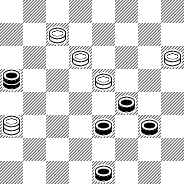 BLACK (you)
BLACK (you)
The tension in the air is electric. Your five minutes are almost up. You've narrowed your choices down to two moves: 2-6, and 2-7. Somehow, you know that one of these moves will result in victory and a life of ease, while the other will lead to ignominious defeat and a quick return to your old back-breaking job at the quarry pits.
What move do you choose? Can you show how that move wins and why the other move loses?
Make your choice carefully; a lot is riding on it. Then take a look at the animated solutions in which Black wins or White wins.
Pages: «Prev
|
1 |
2 |
3 |
...|
60 |
61 |
62 |
63 |
Next»
The Checker Maven is produced at editorial offices in Honolulu, Hawai`i, as a completely non-commercial public service from which no profit is obtained or sought. Original material is Copyright © 2004-2024 Avi Gobbler Publishing. Other material is the property of the respective owners. Information presented on this site is offered as-is, at no cost, and bears no express or implied warranty as to accuracy or usability. You agree that you use such information entirely at your own risk. No liabilities of any kind under any legal theory whatsoever are accepted. The Checker Maven is dedicated to the memory of Mr. Bob Newell, Sr.

